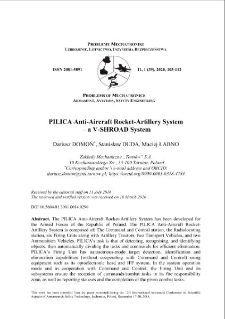Nasza Biblioteka Cyfrowa udostępnia 1 868 obiektów cyfrowych
Obiekt
Tytuł: PILICA Anti-Aircraft Rocket-Artillery System – a V-SHROAD System ; PILICA Anti-Aircraft Rocket-Artillery System – a V-SHROAD System
Tytuł odmienny:
Przeciwlotniczy System Rakietowo-Artyleryjski PILICA – system bardzo krótkiego zasięgu ; Przeciwlotniczy System Rakietowo-Artyleryjski PILICA – system bardzo krótkiego zasięgu
Współtwórca:
Stanisław DUDA, Maciej ŁABNO ; Stanisław DUDA, Maciej ŁABNO
Abstrakt:
The PILICA Anti-Aircraft Rocket-Artillery System has been developed for the Armed Forces of the Republic of Poland. The PILICA Anti-Aircraft Rocket-Artillery System is composed of: The Command and Control station, the Radiolocating station, six Firing Units along with Artillery Tractors, two Transport Vehicles, and two Ammunition Vehicles. PILICA's task is that of detecting, recognising, and identifying objects, then automatically dividing the tasks and commands for efficient elimination. PILICA’s Firing Unit has autonomous-mode target detection, identification and elimination capabilities (without cooperating with Command and Control) using equipment such as its optoelectronic head and IFF system. In the system operation mode and in cooperation with Command and Control, the Firing Unit and its subsystems ensure the reception of commands/combat tasks in its fire responsibility zone, as well as reporting statuses and the completion of the given combat tasks. Reporting and command reception from the Command and Control station is automated. The Firing Unit can fire using its automatic tracking system, or when operated in manual mode. The Firing unit has been equipped with a portable remote control console, providing the ability to use it remotely. In case of a power supply malfunction in the Firing Unit, it is possible to use it entirely manually, with the use of artillery weapons. The Firing Unit is equipped with a stabilised, optoelectronic day-night head that enables it to work independently of the weapons when it comes to observation and detecting, as well as identifying, objects. The head constitutes not only an element of the guidance system, but also a source of information for the entire System, as the data on the detected and observed objects is exchanged within the entire command network. PILICA is equipped with a unique formation and training system, providing capabilities for training teams on real equipment, with the use of a virtual simulation management system employing the DIS protocol.
;
The PILICA Anti-Aircraft Rocket-Artillery System has been developed for the Armed Forces of the Republic of Poland. The PILICA Anti-Aircraft Rocket-Artillery System is composed of: The Command and Control station, the Radiolocating station, six Firing Units along with Artillery Tractors, two Transport Vehicles, and two Ammunition Vehicles. PILICA's task is that of detecting, recognising, and identifying objects, then automatically dividing the tasks and commands for efficient elimination. PILICA’s Firing Unit has autonomous-mode target detection, identification and elimination capabilities (without cooperating with Command and Control) using equipment such as its optoelectronic head and IFF system. In the system operation mode and in cooperation with Command and Control, the Firing Unit and its subsystems ensure the reception of commands/combat tasks in its fire responsibility zone, as well as reporting statuses and the completion of the given combat tasks. Reporting and command reception from the Command and Control station is automated. The Firing Unit can fire using its automatic tracking system, or when operated in manual mode. The Firing unit has been equipped with a portable remote control console, providing the ability to use it remotely. In case of a power supply malfunction in the Firing Unit, it is possible to use it entirely manually, with the use of artillery weapons. The Firing Unit is equipped with a stabilised, optoelectronic day-night head that enables it to work independently of the weapons when it comes to observation and detecting, as well as identifying, objects. The head constitutes not only an element of the guidance system, but also a source of information for the entire System, as the data on the detected and observed objects is exchanged within the entire command network. PILICA is equipped with a unique formation and training system, providing capabilities for training teams on real equipment, with the use of a virtual simulation management system employing the DIS protocol.
Miejsce wydania:
Warszawa
;
Warszawa
Wydawca:
Wojskowa Akademia Techniczna ; Wojskowa Akademia Techniczna
Data utworzenia:
Data złożenia:
Data akceptacji:
Data wydania:
Rozmiar:
Identyfikator:
oai:ribes-88.man.poznan.pl:2579
Sygnatura:
DOI 10.5604/01.3001.0014.0290 ; DOI 10.5604/01.3001.0014.0290
ISSN elektroniczny:
ISSN drukowany:
Język:
Właściciel praw:
Wojskowa Akademia Techniczna ; Wojskowa Akademia Techniczna
Strona początkowa:
Strona końcowa:
Tom:
Słowa kluczowe:
anti-aircraft system, anti-aircraft set, aerial defence, rocket-and-artillery set, close-range system ; anti-aircraft system, anti-aircraft set, aerial defence, rocket-and-artillery set, close-range system
Kolekcje, do których przypisany jest obiekt:
Data ostatniej modyfikacji:
29 wrz 2025
Data dodania obiektu:
29 wrz 2025
Liczba wyświetleń treści obiektu:
0
Wszystkie dostępne wersje tego obiektu:
https://ribes-88.man.poznan.pl/publication/2895
Wyświetl opis w formacie RDF:
Wyświetl opis w formacie OAI-PMH:
| Nazwa wydania | Data |
|---|---|
| PILICA Anti-Aircraft Rocket-Artillery System – a V-SHROAD System | 29 wrz 2025 |

